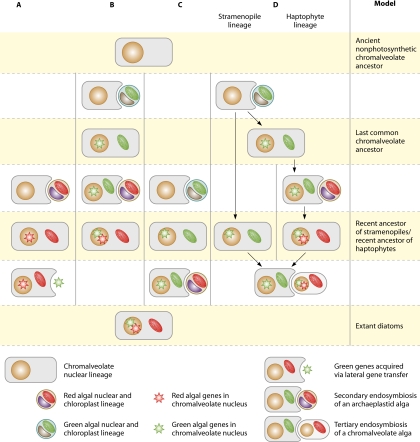I. Primary Prokaryote-Pre LECA Symbiosis Period : Evolution of LECA, Amorphea, and Diaphoretickes 2.0 Gya .
There are 3 leading scenarios for the beginnings of the eukaryotic tree of life. One suggest that LECA was an Amoebozoan which evolved into Opisthokonta, Excavates, and Arachaeplastida. The second scenario believes LECA was an Excavate (particularly Collodictyon related) which subsequently branched into animal and plant lineages (unikonts and bikonts). The third scenario suggests that LECA was similar to Breviata which evolved into Excavates, Opisthokonta, Amoebozoa and Archaeaplastida .
A more radical approach to LECA suggest that it was a Complex radiolarian that released endosymbiotic elements to create multiple free living organism types.
It is proposed that delta proteobacteria symbiosed first with rapid evolution to hydrogenosomes in the earliest Anaerobic Excavata, Amoebozoa, and Fungi. Other events included Actinobacterial symbiosis with resultant peroxisome formation, and SARS11 alpha proteobacterial symbiosis in all aerobic cells. Some symbioses may have been aborted or temporary relationships but undoubtably many types of bacterial combinations were tried. The symbioses developed from codependent vitamin and nutrient requirements of previously free living organisms. Nutrient starvation periods would have been particularly conducive to symbiogenesis.
The serial primary symbiosis of green and red cyanobacteria in the Archaeaplastida were major innovations around 2.7 Gya. Formation of these primary endosymbionts paved the way for subsequent encapsulation events.
The symbiotic processes of bacteria + eukaryote incorporate bacteriophage infections that enable productive and mutually dependent benefits. The formula for primary endosymbiosis is (bacteriophage + bacterium + eukaryocyte = new eukaryocyte ) . The endosymbiotic process was probably very fast in geological time scales. (less than 10000 years).
A Map of the Primary Symbiotic period is provided below:
II. Secondary Eukaryote + Eukaryote Symbiosis Period : Evolution of Euglenozoa , CCHT, and SAR

III. Tertiary Eukaryote Symbiosis Period : Euglenoid symbiosis in Cryptophytacea , Stamenopiles-Diatoms, Radiolaria, Foraminifera
IV. Quartenary Eukaryote Symbiosis Period : Primary enslavement of tertiary endosymbionts, secondary enslavement of tertiary endosymbionts, and hybrid tertiary-tertiary organisms.
V. Metazoan Evolution involving transfers of embedded Transposable Elements . ( ie.; birds flying with attached snails containing parasites with transposon containing viruses. Or, flying insects with parasites and transposon containing viruses that influence distant speciation events ) Combinations of DNA Transposons are responsible radiation events in Eukaryotes. A history of these elements helps elucidate major mechanisms of eurkaryotic macroevolution.
